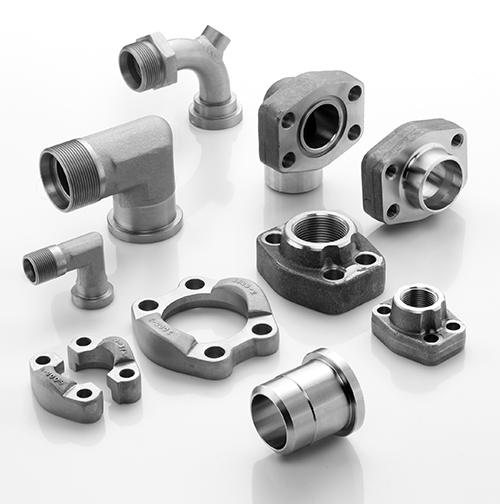By Josh Cosford, Contributing Editor
Permanent plumbing connections, such as those piped or welded, offer the most reliable form of connection for your hydraulic system. But, of course, when the connection is neither flexible (like a hose) nor detachable (like a weld), you have little reason ever to remove the plumbing until you change the circuit or decommission the machine entirely.

Most of the challenges in hydraulic connection types revolve around producing an effective seal in a removable package. Early removable fittings, such as NPT and JIC, counted on metal-to-metal sealing surfaces to reliably transmit fluid under pressure. Unfortunately, the deformation of NPT threads makes them a one-hit wonder, which works best when installed once and left to do its job. The JIC flare fitting is a common and practical choice for tubes and hoses with frequently removed and replaced connections (think test stands or training systems). However, the flat metal-to-metal sealing surfaces do little in offering long-term reliability.
Most modern sealing systems use polymer technology to contain your expensive hydraulic fluid effectively, from the various O-ring boss technologies (ORB, BSPP and Metric) to the end-face connections such as SAE O-Ring Face. The ORF hose end enjoys the current standard as the go-to hydraulic hose connection, offering an effective seal with zero leakage and an easy and cheap replacement O-ring.
However, another O-ring face technology provides a popular intermediate connection with myriad possible options — the SAE flange. Defined under SAE standard J518, the system uses four bolts to fix a flat flange against the also-flat work port on a pump, motor, cylinder or valve. The ported surface offers an entirely flat area to accept the O-ring situated inside a machined groove on the flange. Four bolts inserted through holes on the flange provide the means to compress the polymer seal, providing legendary high-pressure capacity.
Two pressure capacity ratings are defined under the SAE J518 standard. The Code 61 flange provides a connection suitable for everything 3,000 psi or less, while the Code 62 flange provides a leak-free connection up to 6,000 psi. Although the pressure capacity varies — as you would expect — with port size, only the 2-1/2 in. and larger size Code 61 flanges cannot hold 3,000 psi. Code 62 flanges offer 6,000 psi across the board, but most manufacturers offer only up to 2 in. ports. If you need more than a couple of hundred gpm capacity, you may need to double up the plumbing or find custom flanges.
Code 61 and 62 flanges differ more than by their pressure capacity. Instead, the flange’s size and general beefiness are reflected by its pressure rating. Taking the 2 in. flanges as an example, Code 61 uses ½ in. bolts spaced about 3 x 1.7 in. in a 7/8 in. thick flange. Conversely, the Code 62 unit upgrades to massive ¾ in. bolts across 3.8 x 1.75 in. respectively.
SAE flanges offer two methods of attaching plumbing: split flange concept or standard port adapters. The split flange traps the O-ring face hose end against the mounting surface, allowing quick and leak-free connection to a hose. In addition, the split flanges allow the technician to rotate the hose end in any direction before tightening, avoiding the need for any swivel despite individual plumbing requirements.
Flanges are easily integrated with traditional and existing hydraulic plumbing packages as well. Stand-alone flanges threaded with female ports such as NPT, ORB or BSPP provide versatility, allowing any newer flange-equipped pump, motor or cylinder to adapt quickly to the hoses and fittings already on the machine. The exceptional, leak-free pressure capacity of SAE J518 flanges, combined with their various configurations, makes it the current king of high-pressure plumbing.
Filed Under: Components Oil Coolers, Couplings & Fittings, Engineering Basics, Hose Assembly Tips